Occasionally I rerun a favorite older post. This one was originally published over eight years ago. For this version I’ve changed the title, edited the text, tweaked the formatting and deleted one photo that was irrelevant to the subject at hand.
Yesterday at Farmington Bay WMA I photographed a Pied-billed Grebe using what may be the most interesting diving technique out of the seven distinctly different diving techniques they’re known to employ. This one is called “gradual sinking”.
I’ve photographed it before but this time I was close, I had excellent detail and the bird was broadside to me, which is the best shooting angle for demonstrating the unique aspects of the dive.
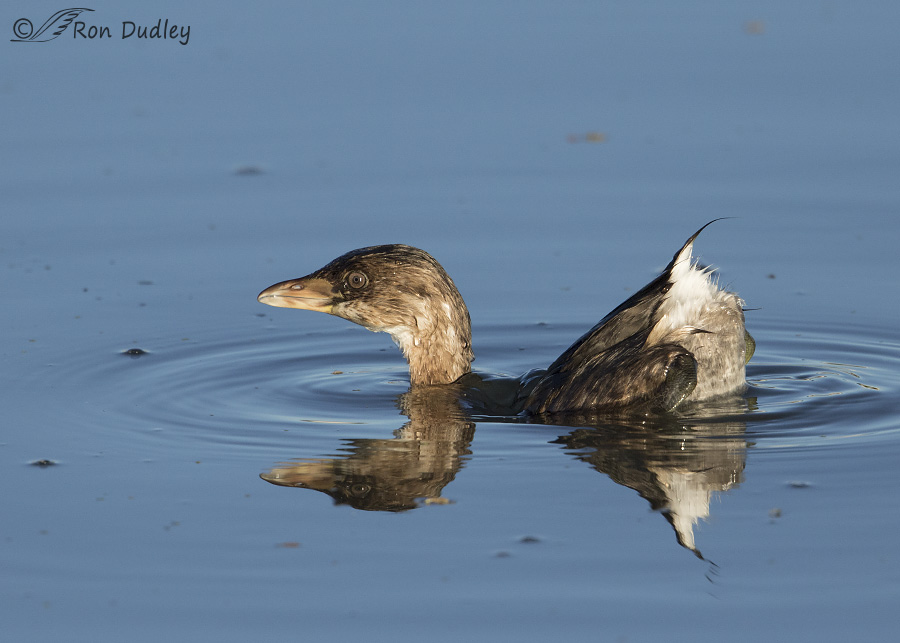
1/3200, f/6.3, ISO 800, Canon 7D Mark II, Canon EF 500mm f/4L IS II USM + 1.4 tc, not baited, set up or called in
By the time I was able to acquire focus on the bird “he’ had already begun to dive. When they do this they’re usually spooked by something and at first I didn’t know what it was.
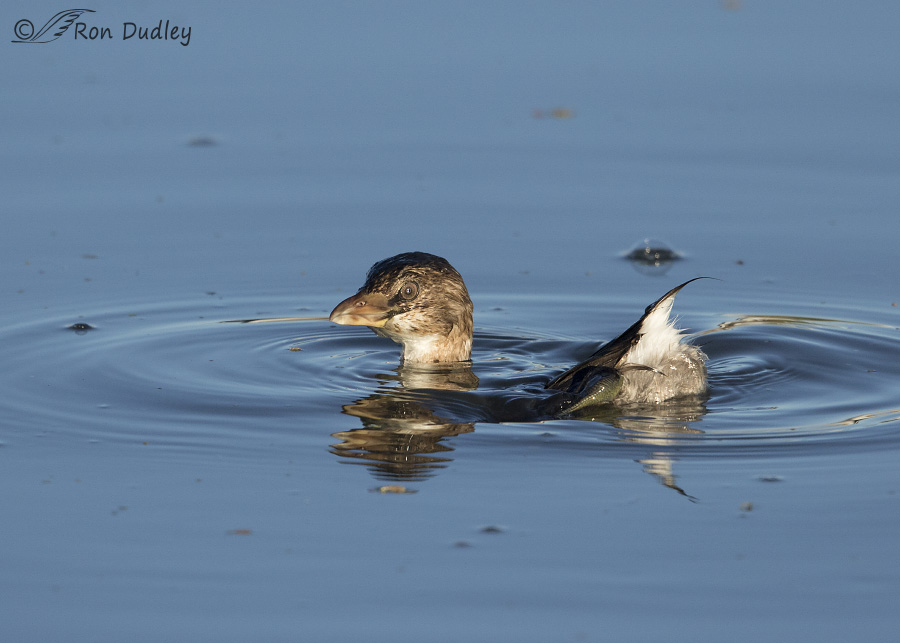
1/3200, f/6.3, ISO 800, Canon 7D Mark II, Canon EF 500mm f/4L IS II USM + 1.4 tc, not baited, set up or called in
But it soon became apparent that his attention was focused on my pickup so I believe it was little ol’ me that made him nervous. Probably because I was so close.
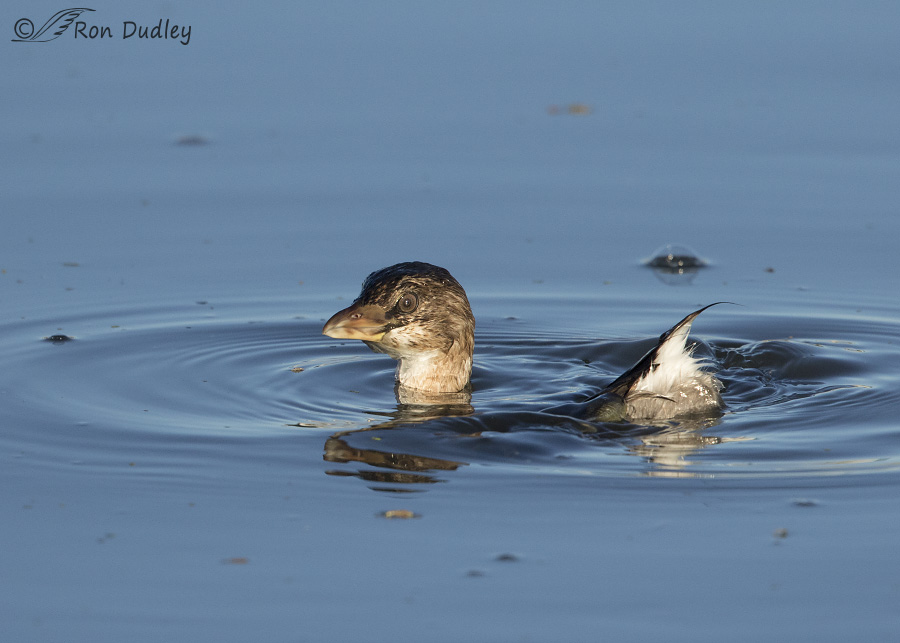
1/3200, f/6.3, ISO 800, Canon 7D Mark II, Canon EF 500mm f/4L IS II USM + 1.4 tc, not baited, set up or called in
He held this position for a moment as he watched me but soon…
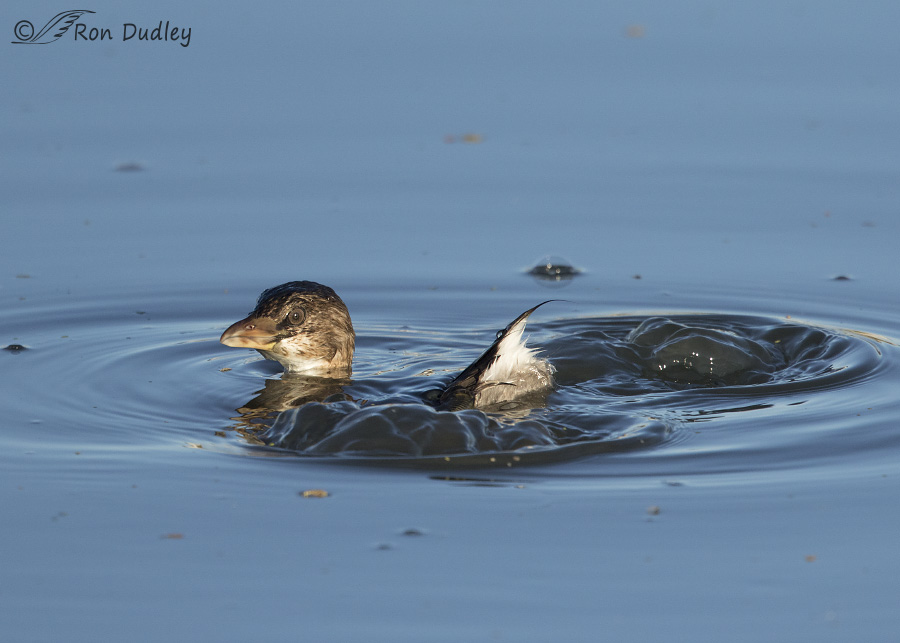
1/2500, f/6.3, ISO 800, Canon 7D Mark II, Canon EF 500mm f/4L IS II USM + 1.4 tc, not baited, set up or called in
he once again began to sink. From the water welling up on both sides of the bird we can see that he’s now using his legs and feet to propel himself straight down. His legs, feet and especially his hips must be almost unbelievably flexible.
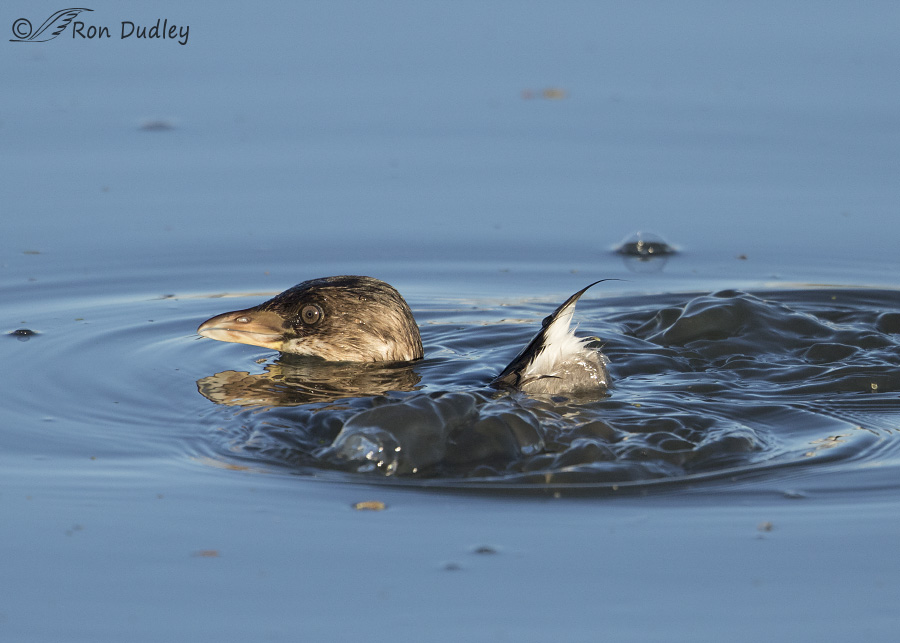
1/2500, f/6.3, ISO 800, Canon 7D Mark II, Canon EF 500mm f/4L IS II USM + 1.4 tc, not baited, set up or called in
In my experience they always turn their head forward again just before their head goes under the surface (a minor observation but it’s something I’ve noticed).
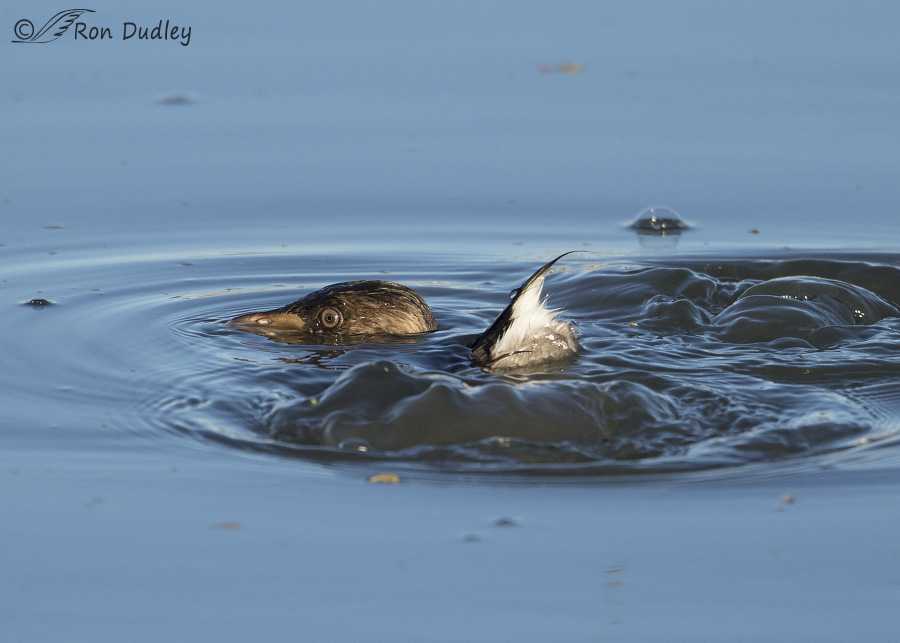
1/2500, f/6.3, ISO 800, Canon 7D Mark II, Canon EF 500mm f/4L IS II USM + 1.4 tc, not baited, set up or called in
Close observation of the water ripples around his head shows that there is absolutely no forward movement during this process. The bird is propelling himself straight down.
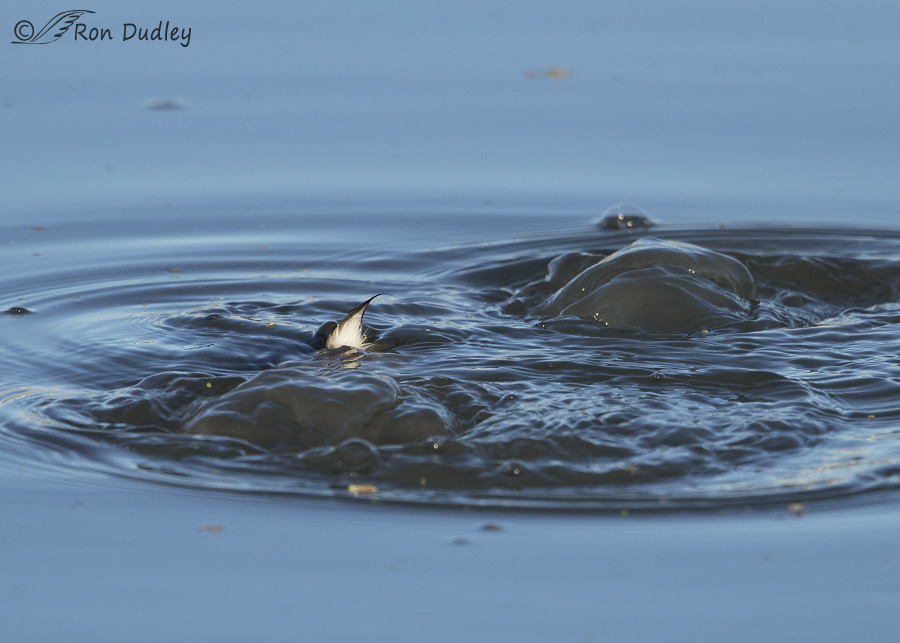
1/2500, f/6.3, ISO 800, Canon 7D Mark II, Canon EF 500mm f/4L IS II USM + 1.4 tc, not baited, set up or called in
As always, the last body part to disappear was the tip of his cute little tail.
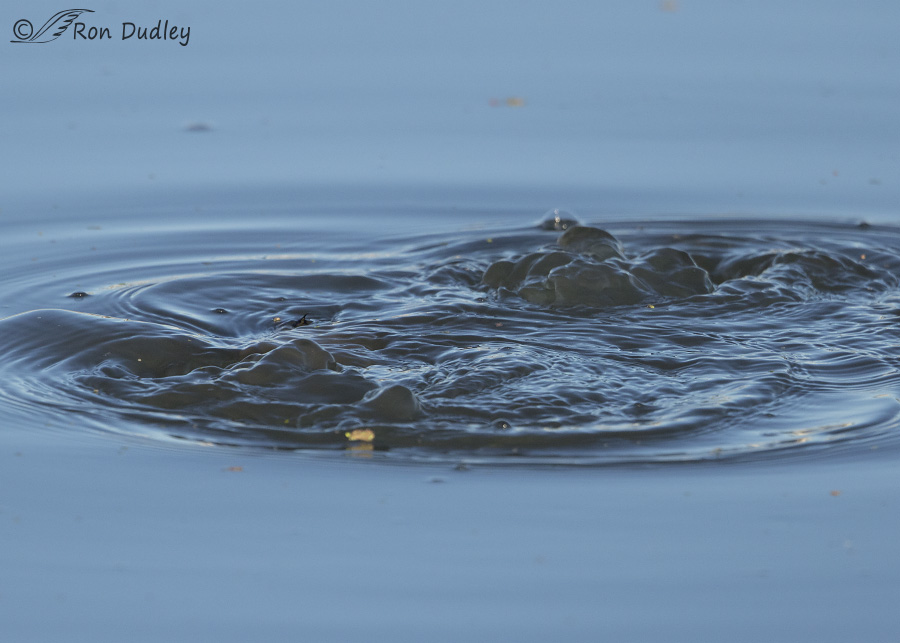
1/2500, f/6.3, ISO 800, Canon 7D Mark II, Canon EF 500mm f/4L IS II USM + 1.4 tc, not baited, set up or called in
Immediately after he disappeared from the surface, turbulence was the only evidence that he’d been there.
I don’t recall seeing any other bird species use this diving technique, including other grebe species. If you’re aware of any that do, I’d like to hear about it.
Ron
PS – Preparing this post for its rerun brought back many bad memories when I realized the date of the original post, which was October 27, 2015. Later that same evening, my daughter Shannon in Florida fell in her kitchen and suffered a severe traumatic brain injury (TBI) from which she was given no chance to recover. Thankfully the ER doctors were wrong and she did eventually recover, mostly, but our lives were forever changed.
Be careful out there folks, even when performing mundane daily activities.


Yikes on the date/memory. So glad Shannon is better now. That was a scary time. You kept us in the loop which was incredibly kind of you.
In Louisiana, there is a little water bird that I learned to call a Pulldoo. It just folds up and goes under water. You never know where it may show up. I have tried to look it up, but I cannot find it. It is VERY small (least grebe size) but it pulls itself inward and goes under. But it is very fast.
It is VERY small (least grebe size) but it pulls itself inward and goes under. But it is very fast. 
This is the technique that I use when I’ve done something stupid and embarrassed myself. You know that sinking feeling or you just want to sink out of sight.
I’ll have to try it next time I’m in that situation. Which, knowing me, will probably be soon…
Fascinating dive technique — like half of a synchronized swim team. Best part of the post is the amazing recovery Shannon has made!


Thank you, Marty. I agree with you about the “best part”.
Love this re-posting from before. When you said dive I was thinking of head down first. I too would like to see under the water how it all takes place. Do you know how long they stay under the water and if they swim away or just pop back up after a short time?
Trudy, in response to your question. My friend Jay Banta used to be Manager of Fish Springs National Wildlife Refuge before he retired. Jay made the following comment on this post on Facebook:
“Ron: one of my memories of Fish Springs is having a duck hunter coming to the office and saying “I got a duck (meaning he shot it) but I don’t know what kind it is. It just sunk in place and then came back up again.” My Assistant Mgr. Erich and I and looked at each other with a silent “Ah shit.” look. That guy got a $225 lesson on bird id.”
Getting to things late today but in response to Trudy’s question – I have often seen Pied-billed Grebes slowly sink like this. Most often they surface some distance away but distance is variable. An old reference I have seen says that they can go 50-60 feet away and stay under more than one minute. But when I see them surface far away from where they sank I don’t know if that’s the first time to surface since the dive or if they came up in between. That’s because I don’t know to look and may have missed the first time. Also it’s because they don’t always fully surface. Many times I have seen a grebe sink and a moment later poke just its head up near where it sank. It may stay with only its head barely above water for a few moments then re-submerge and fully surface elsewhere. I have seen American Wigeon swim over and steal water plants from coots as they surface. Several time I have seen them head for a Pied-billed Grebe but I’ve never seen them succeed with a grebe. The grebe quickly dives and resurfaces far away. Fun birds to watch.
Dan, thanks for that info based on your extensive experience.
This series had me laughing – more and more with each photo! What a great capture!
And then your poignant realization of the date of the post. I’m so glad the ending wasn’t as you’d feared.
Thanks, Carolyn. On both counts.
Very interesting Ron. I have watched them and photographed them, but never paid that much attention to how they make the dive. That left side eye that is watching you as it proceeds with the dive is very focused. The Grebe is not going to postpone the dive because of you, but at the same time it is obviously concerned with your presence. I don’t think I have been an FP follower for 8 years so don’t think I have seen this before. Excellent series. Like #5 best.
Thanks, Everett. I just checked. You made your first comment on 2/08/18 on this post.
https://www.featheredphotography.com/blog/2018/02/08/preening-rough-legged-hawk-the-rest-of-the-story/
Thanks Ron – so 6 years – wow time flies – and it has been fun and educational
WOW! Good thing it’s deliberate and forward motion is not necessary to float! Would be neat to have an underwater camera to catch the sub-surface action.
Would be neat to have an underwater camera to catch the sub-surface action.
Doesn’t seem that long ago that Shannon had her fall! I remember it well and your hoping to get there before the predicted end. She’s made an amazing recovery even if not total…..
“Sounds” like I have at least one LEO in the vicinity – took a bit to figure out what it was.
“Would be neat to have an underwater camera to catch the sub-surface action.”
I’ve thought the same thing Judy, many times.
Congrats on your LEOW. Jealous.
“Gradual sinking”–who knew ? In trying to imagine how the grebe
does this, all I could picture was something like “treading water”, which accomplishes the very opposite ! How does it work ? Does
the grebe have some way of expelling air from between its feathers
or, ? I learn something new from FP in 9 out of 10 posts……
“Does the grebe have some way of expelling air from between its feathers?”
Yes they do, Kris. Like many other diving birds, they flatten their feathers against their body which expels air from between their feathers, making them less buoyant.
But in this species that’s only an accessory method of helping them sink. Mostly it’s the driving force of their webbed feet, pushing sideways and upwards, that forces them straight down.
Seven known techniques! That is so interesting. Never knew that before. Now I’m gonna have to look that up.
I would suppose that the gradual sinking technique is often employed when the bird is trying hard not to draw too much attention to itself by discreetly disappearing below the water; no water flying in the air or sound of splashing. It is quite clever.
Thanks professor!
Yup, seven. They include springing dive, gradual sinking, crash dive, patter dive, dive with young, ripple dive and bluff dive.
Thank you, Michael.